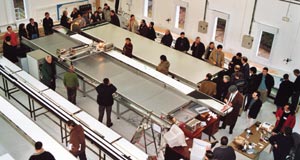
The first module for the target tracker for OPERA (Oscillation Project with Emulsion-tRacking Apparatus) was centre stage at the Institut de Recherches Subatomiques (IReS) in Strasbourg in January, when the OPERA collaboration met there to launch the construction of the detector. The target tracker is being built in Strasbourg, where two halls at IReS have been provided for its construction.
Now that the latest results from the KamLAND experiment have indicated a large mixing angle (LMA) solution for the oscillation of solar neutrinos, OPERA has increased its chances of making the next discovery in the field of neutrino oscillations. Using the CERN muon neutrino beam to Gran Sasso (CNGS), OPERA aims to observe an unambiguous νμ → ντ oscillation. The scheduled start-up of the CNGS beam over the summer of 2006 leaves the OPERA collaboration with little time to build and install its detector in Italy’s Gran Sasso Underground Laboratory. The main purpose of the meetings in Strasbourg was to define and plan all the construction and installation phases.
The OPERA detector combines photographic emulsion and electronic detection techniques, and comprises a target part and a spectrometer part. The target part consists of alternate walls of lead/ emulsion bricks and modules of scintillator strips for the target tracker. The main purpose of the tracker is to identify the brick where a neutrino interaction is likely to be. The 7 m long scintillator strips will have grooves into which wavelength-shifting fibres will be glued and read out by 64-channel multianode photomultipliers. Computer-operated robotic manipulators will extract the bricks identified by the tracker. The emulsions will then be developed and scanned using automated microscopes.
The spectrometer part, which is essential to detect muons emerging from neutrino interactions, will consist of a precision drift-tube tracker, a magnet producing a 1.55 Tesla magnetic field and RPCs inserted into the magnets. The collaboration comprises some 150 physicists from a wide range of countries and expects to be data-taking for the period 2006-2011.





